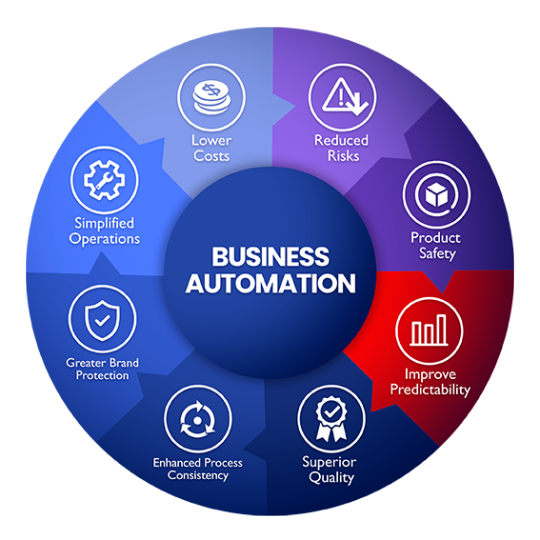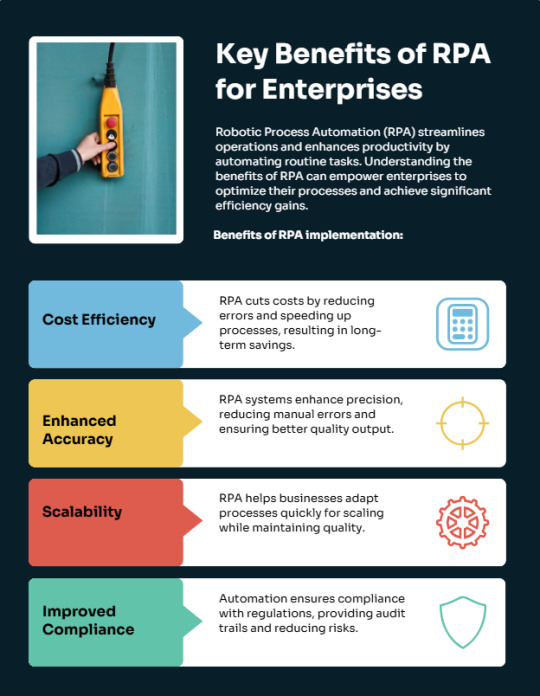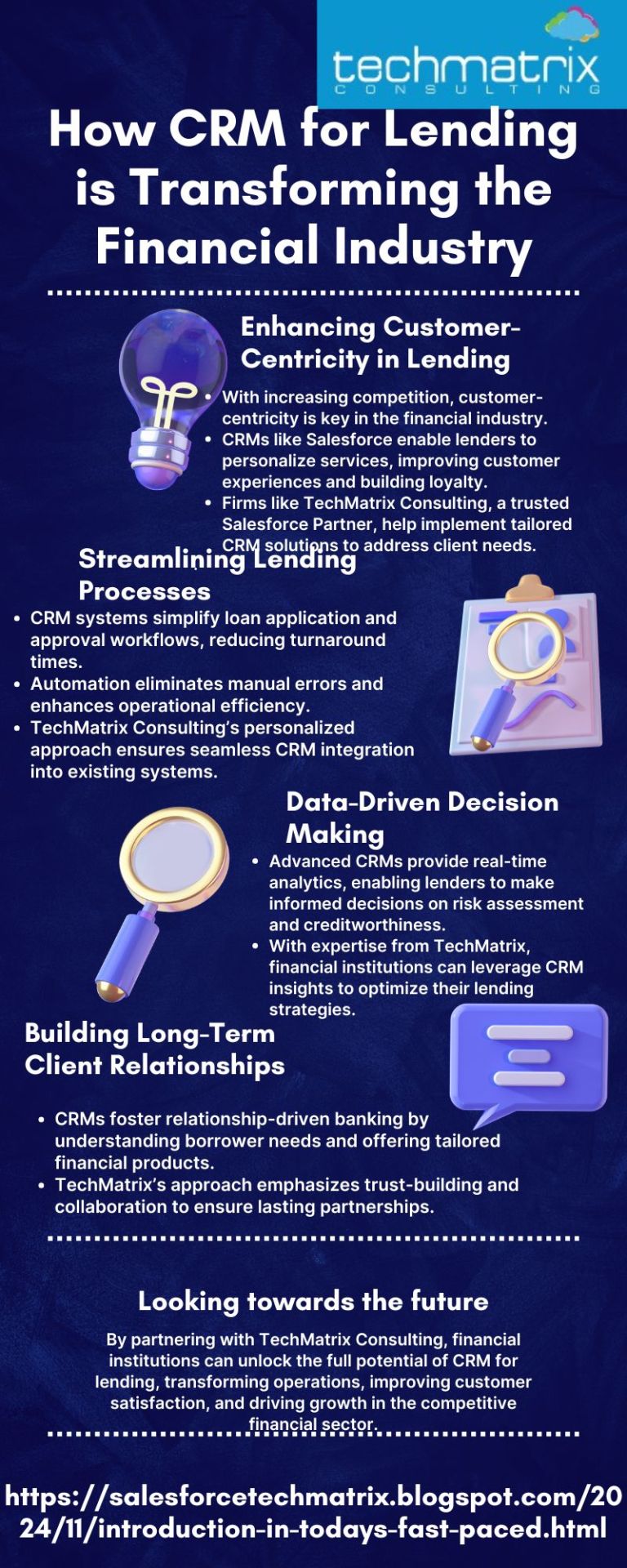#Benefits of process automation
Explore tagged Tumblr posts
Text
14 Key Benefits of Business Process Automation
Process automation offers numerous benefits that can significantly impact businesses and organizations. Some of the key benefits of process automation include:
Increased Efficiency: Automation reduces the need for manual intervention in repetitive tasks, leading to faster and more streamlined processes. This allows employees to focus on more strategic and value-added activities, improving overall productivity.
Cost Savings: Automated processes can lead to significant cost savings by reducing labor costs, minimizing errors, and optimizing resource allocation. It reduces the need for human resources to perform repetitive tasks.
Improved Accuracy and Quality: Automation minimizes the chances of human errors, ensuring a higher level of accuracy and consistency in operations. This results in improved overall quality of products and services.

Consistency and Standardization: Automation ensures that processes are executed consistently according to predefined rules and standards. This standardization leads to uniform outcomes and better customer experiences.
Faster Process Execution: Automated processes can operate 24/7 without breaks, resulting in faster task execution and quicker response times to customer needs and market changes.
Enhanced Compliance: Process automation helps businesses adhere to industry regulations and internal policies by enforcing standardized procedures and generating accurate documentation.
Scalability and Flexibility: Automated processes can easily handle an increased workload without the need for significant adjustments, making them scalable and adaptable to changing business needs.
Improved Data Management and Insights: Automation generates data and analytics that provide valuable insights into process performance. Making data-driven decisions and locating bottlenecks can both benefit from these insights.
Enhanced Customer Experience: Automation can lead to faster response times and improved customer service. Features like automated emails, chatbots, and self-service portals can provide immediate support to customers.
Streamlined Collaboration: Automation facilitates better collaboration between different departments and teams by automating workflows and ensuring seamless information flow.
Business Agility: Automation enables businesses to respond quickly to market changes and opportunities, allowing for faster adaptation and decision-making.
Time Savings: Automated processes can save considerable time, allowing organizations to complete tasks and deliver products or services more quickly to customers.
Competitive Advantage: Embracing process automation can give a company a competitive edge by enabling faster, more efficient, and cost-effective operations, leading to better customer satisfaction and retention.
Employee Satisfaction: By automating repetitive and mundane tasks, employees can focus on more challenging and creative work, leading to higher job satisfaction and engagement.
Overall, process automation can transform how businesses operate by optimizing workflows, increasing productivity, and enhancing overall performance. However, it's crucial to carefully plan and implement process automation to ensure it aligns with the organization's goals and processes. Additionally, continuous monitoring and improvements are essential to maintaining the effectiveness of automated processes over time.
#process automation#ai automation#what is automation#Cambay#Robotic Process Automation#Business Process Automation#Benefits of process automation
0 notes
Text
Unlocking Efficiency and Innovation: The Role of Robotic Process Automation (RPA)

In today's fast-paced and competitive business environment, organizations are constantly seeking ways to improve efficiency, reduce costs, and increase productivity. Robotic Process Automation (RPA) has emerged as a powerful tool that can help businesses achieve these objectives.
What is Robotic Process Automation (RPA)?
Robotic Process Automation (RPA) is a technology that allows businesses to automate repetitive, rule-based tasks. It uses software robots, also known as "bots," to mimic human actions and interact with digital systems. These bots can log into applications, navigate through screens, input data, and complete tasks just like humans would.
The Role of RPA in Business:
RPA can be used to automate a wide range of tasks across various industries and departments. Here are some examples:
Finance and Accounting: Automating tasks such as accounts payable and receivable, invoice processing, and financial reporting.
Customer Service: Automating tasks such as answering FAQs, resolving customer inquiries, and processing orders.
Human Resources: Automating tasks such as onboarding new employees, processing payroll, and managing benefits.
IT: Automating tasks such as provisioning accounts, managing user access, and deploying software updates.
Impact of RPA on Businesses:
Implementing RPA can offer numerous benefits to businesses, including:
Increased efficiency and productivity: RPA can automate time-consuming and tedious tasks, freeing up employees to focus on more strategic and value-added activities.
Reduced costs: RPA can help businesses save money on labor costs, as well as reduce errors and compliance risks.
Improved accuracy and compliance: RPA bots are programmed to follow specific rules and procedures, which can help to improve accuracy and compliance with regulations.
Enhanced process visibility and control: RPA provides businesses with a clear view of their processes, which can help them identify and address bottlenecks.
Improved customer satisfaction: RPA can help businesses improve customer satisfaction by automating tasks such as order processing and customer service interactions.
RPA Services:
Implementing RPA successfully requires a partner with expertise in the technology and a deep understanding of business processes. A comprehensive RPA solution should include the following services:
Document AS-IS Process: This involves mapping out the existing process to identify areas for automation.
Design & Development of Bots, workflows, and forms for process automation: This includes designing and developing the software robots that will automate the tasks.
Bot license (We will use the appropriate underlying technology): This provides access to the software robots and the underlying technology platform.
Infrastructure: This includes setting up the necessary infrastructure to support the Robotic Process Automation (RPA) solution.
Production Deployment of the Bots: This involves deploying the bots to production and monitoring their performance.
RPA support: This includes ongoing support for the RPA solution, such as troubleshooting and maintenance.
Test & Deploy bots to production: This involves testing the bots in a production environment and making any necessary adjustments before they are deployed to full production.
Configuration data changes: This involves making changes to the configuration data of the bots as needed.
Password updates: This involves updating the passwords of the bots as needed.
Errors in executing the Bots: This involves resolving errors that occur during the execution of the bots.
Determining the “root cause” of a recurring issue or incident & recommendations: This involves identifying the root cause of a recurring issue or incident and recommending solutions to prevent it from happening again.
Infrastructure/application related issues: This involves resolving issues with the infrastructure or applications that the bots are interacting with.
Conclusion:
RPA is a powerful technology that can have a significant impact on businesses of all sizes. By automating repetitive tasks, RPA can help businesses improve efficiency, reduce costs, and increase productivity. However, it is important to choose a reputable Robotic Process Automation (RPA) companies with the expertise and experience to help you implement a successful RPA solution.
Ready to embrace the power of RPA?
Contact us today to learn more about how RPA can help your business achieve its goals.
#robotic process automation#robotic process automation rpa#rpa automation#robotic process automation software#rpa software#robotic process automation companies#robotic process automation technology#robotic process automation in healthcare#robotic process automation in banking#rpa solution#robotic process automation for finance#process automation solution#robotic process automation services#robotic process automation for insurance#rpa system#what is rpa automation#robotic process automation solution#robotic process automation benefits#robotic process automation consulting#robotic process automation consultant#rpa service provider#rpa consulting services
2 notes
·
View notes
Text
Nvidia Becomes First $4 Trillion Company Amid AI Boom
On July 9, Nvidia made history by becoming the first company to surpass $4 trillion in market value, marking a defining moment in Wall Street’s confidence in the transformative power of artificial intelligence.
Led by co-founder and electrical engineer Jensen Huang, Nvidia's stock surged as high as $164.42 after the market opened, briefly pushing its valuation past the $4 trillion threshold before dipping slightly.
Steve Sosnick of Interactive Brokers noted, “The market has an incredible certainty that AI is the future. Nvidia is certainly the company most positioned to benefit from that gold rush.”
Nvidia’s valuation now exceeds the GDP of nations like France, the UK, and India, showcasing how central AI has become to economic outlooks. Investors are betting big that AI will spark a new wave of automation, robotics, and productivity growth—disrupting traditional industries in the process.

The California-based chipmaker’s success is also lifting broader markets. Even amid ongoing tariff tensions, Nvidia’s momentum and investor optimism have helped the S&P 500 and Nasdaq hover near record highs.
Much of this recovery stems from relief that former President Trump has eased some of the harshest tariffs announced earlier this year. Still, trade uncertainty remains, especially with new tariff actions recently introduced.
Despite facing U.S. export restrictions to China, Nvidia continues to expand globally. Its AI infrastructure deal in Saudi Arabia, signed during Trump’s May visit, reflects strategic growth even within complex geopolitical landscapes.
With AI driving explosive market gains and Nvidia at the center of the storm, the chip giant is not just rewriting stock market records—it’s redefining global economic influence.
#On July 9#Nvidia made history by becoming the first company to surpass $4 trillion in market value#marking a defining moment in Wall Street’s confidence in the transformative power of artificial intelligence.#Led by co-founder and electrical engineer Jensen Huang#Nvidia's stock surged as high as $164.42 after the market opened#briefly pushing its valuation past the $4 trillion threshold before dipping slightly.#Steve Sosnick of Interactive Brokers noted#“The market has an incredible certainty that AI is the future. Nvidia is certainly the company most positioned to benefit from that gold ru#Nvidia’s valuation now exceeds the GDP of nations like France#the UK#and India#showcasing how central AI has become to economic outlooks. Investors are betting big that AI will spark a new wave of automation#robotics#and productivity growth—disrupting traditional industries in the process.#The California-based chipmaker’s success is also lifting broader markets. Even amid ongoing tariff tensions#Nvidia’s momentum and investor optimism have helped the S&P 500 and Nasdaq hover near record highs.#Much of this recovery stems from relief that former President Trump has eased some of the harshest tariffs announced earlier this year. Sti#trade uncertainty remains#especially with new tariff actions recently introduced.#Despite facing U.S. export restrictions to China#Nvidia continues to expand globally. Its AI infrastructure deal in Saudi Arabia#signed during Trump’s May visit#reflects strategic growth even within complex geopolitical landscapes.#With AI driving explosive market gains and Nvidia at the center of the storm#the chip giant is not just rewriting stock market records—it’s redefining global economic influence.
0 notes
Text
How CRM Workflow Automation Transforms Sales, HR, and Finance Operations?
The competitive landscape in today’s business, agility and efficiency are key to staying ahead. With rapid digital transformation across industries, companies are increasingly turning to Customer Relationship Management (CRM) systems with workflow automation to streamline operations. While traditionally associated with sales and customer service, modern CRM platforms have evolved into powerful tools that also optimize HR and finance functions.
Read more: CRM Workflow Automation
#CRM workflow automation#CRM automation benefits#CRM for HR processes#CRM in finance automation#LionOBytesUSA
0 notes
Text
Stay ahead with the latest trends in AI agents. Learn how these autonomous tools are reshaping industries, from finance to healthcare.

Discover how AI agents are transforming industries with intelligent automation, boosting efficiency, and enabling smarter decision-making in 2025 and beyond.
#AI agents#autonomous AI agents#intelligent agents#AI automation#AI-powered tools#artificial intelligence agents#AI agents in business#AI customer service agents#AI agents for startups#AI automation for enterprises#AI virtual assistants#workflow automation#generative AI#AI trends 2025#future of AI#machine learning agents#conversational AI#AI task automation#how AI agents work#benefits of AI agents#best AI agents for productivity#using AI agents in business#AI agents for process automation#top AI agents tools
1 note
·
View note
Text
Why Outsourcing Accounts Payable Improves Financial Control
Accuracy and efficiency are critical to a successful accounts payable process. Errors in vendor payments, duplicate invoices, and late payments can cost businesses time and money. Accounts payable outsourcing helps eliminate these issues by bringing in specialized expertise and automation.
With outsourced AP services, companies benefit from streamlined workflows and dedicated teams who ensure invoices are processed correctly and on schedule. Automation tools used in outsourcing significantly reduce human error and increase processing speed.
One of the most overlooked advantages of accounts payable outsourcing is the ability to generate real-time financial reports and analytics. These insights help companies track cash flow, monitor performance, and make informed financial decisions.
Moreover, outsourced providers ensure strict compliance with regulatory standards, minimizing the risk of audits or penalties. They also use secure systems to handle sensitive data, reducing the likelihood of fraud.
By enhancing the accuracy and speed of financial processes, AP outsourcing improves overall financial health. It allows internal teams to shift focus from data entry to strategic activities, such as budgeting and financial planning. In short, accounts payable outsourcing is an investment in operational excellence.
#AP process efficiency#error reduction in AP#automated invoice processing#outsourced AP benefits#financial process optimization
0 notes
Text
OPM, a top-rated battery container mould manufacturer in Pune, utilizes this process to ensure that its customers receive unparalleled consistency and accuracy in each product.
#battery mould manufacturers#battery insert moulding automation#battery insert moulding automation benefits#battery insert moulding automation process
0 notes
Text
How ERP Systems Streamline Processes and Boost Efficiency
In today’s swiftly changing business environment, organisations are under increasing pressure to streamline their processes, increase their efficiency, and maintain their competitiveness. Enterprise Resource Planning (ERP) systems have emerged as a game-changer, radically altering how businesses function. This article will examine the critical role that ERP System plays in streamlining business…
#Business Automation#Centralized Data#Data Integration in ERP#Enterprise Resource Planning#ERP Benefits#ERP Collaboration#ERP for Efficiency#ERP Systems#Improving Business Operations#Productivity Boost with ERP#Streamlining Business Processes
0 notes
Text
Vertical Glue Mixer: Efficient and Uniform Adhesive Mixing for Plywood Manufacturing

In plywood production, efficiency and precision are the most important factors in ensuring high-quality board production. One of the most crucial elements in this production is the Vertical Glue Mixer—a revolution in uniform adhesive mixing for better plywood bonding. If what you're searching for is an advanced glue mixing technology that maximizes productivity and reduces waste, this futuristic machine is a production-line essential.
Why a Vertical Glue Mixer?
A Vertical Glue Mixer is specifically designed to provide homogeneous adhesive mixing for plywood, ensuring a consistent glue spread on veneers. Unlike conventional mixers, a vertical mixer offers better blending, reduced glue wastage, and improved bonding strength, making it a preferred choice for modern plywood factories.
Key Benefits of a Vertical Glue Mixer
1. Superior Mixing Efficiency
Vertical design allows for complete and even blending of adhesives, which creates even viscosity and consistency across the batch. This produces improved plywood adhesion, minimizing defects in the finished product.
2. Economical Glue Use
Effective adhesive dispensing implies that manufacturers can lower the use of glue without affecting the quality, resulting in extensive cost benefits in the long run.
3. Reduced Production Cycle Times
Using a high-speed mixing device, a vertical glue mixer reduces preparation time, enabling production cycles to be completed quickly and output to be maximized.
4. Minimal Maintenance & Longevity
Designed with robust parts and sophisticated automation, these mixers have negligible maintenance needs, making them a sound long-term investment for plywood production.
5. Eco-Friendly Operations
By minimizing glue waste and maximizing adhesive blending efficiency, a Vertical Glue Mixer supports an environmentally friendlier plywood production process with decreased ecological footprint.
Selecting the Most Suitable Vertical Glue Mixer for Your Plywood Operation
In selecting a Vertical Glue Mixer, there are important considerations to make:
✔️ Mixing Capacity – Select a machine in conformity with your volume of production.
✔️ Automation Features – Choose a model with easy-to-use controls for convenient operation.
✔️ Material Compatibility – Use one that can handle different adhesive types for general applications.
✔️ Manufacturer Reputation – Buy equipment from a reputable plywood machinery manufacturer for guaranteed quality.
A Vertical Glue Mixer is an important investment for plywood plant owners who want to improve efficiency, quality, and cost savings. By adopting this performance-intensive adhesive mixing system into your production process, you can achieve smooth operations, better plywood bonding, and increased profitability.
Want to find the ideal Vertical Glue Mixer for your plywood factory? Contact DNH Engineers a renowned manufacturer of plywood machinery and give your production a boost! Visit www.dnhengineers.com for more details.
#In plywood production#efficiency and precision are the most important factors in ensuring high-quality board production. One of the most crucial elements in this#this futuristic machine is a production-line essential.#Why a Vertical Glue Mixer?#A Vertical Glue Mixer is specifically designed to provide homogeneous adhesive mixing for plywood#ensuring a consistent glue spread on veneers. Unlike conventional mixers#a vertical mixer offers better blending#reduced glue wastage#and improved bonding strength#making it a preferred choice for modern plywood factories.#Key Benefits of a Vertical Glue Mixer#1. Superior Mixing Efficiency#Vertical design allows for complete and even blending of adhesives#which creates even viscosity and consistency across the batch. This produces improved plywood adhesion#minimizing defects in the finished product.#2. Economical Glue Use#Effective adhesive dispensing implies that manufacturers can lower the use of glue without affecting the quality#resulting in extensive cost benefits in the long run.#3. Reduced Production Cycle Times#Using a high-speed mixing device#a vertical glue mixer reduces preparation time#enabling production cycles to be completed quickly and output to be maximized.#4. Minimal Maintenance & Longevity#Designed with robust parts and sophisticated automation#these mixers have negligible maintenance needs#making them a sound long-term investment for plywood production.#5. Eco-Friendly Operations#By minimizing glue waste and maximizing adhesive blending efficiency#a Vertical Glue Mixer supports an environmentally friendlier plywood production process with decreased ecological footprint.#Selecting the Most Suitable Vertical Glue Mixer for Your Plywood Operation
0 notes
Text
Key Benefits of RPA for Enterprises: Boosting Efficiency & Cutting Costs

Discover how Robotic Process Automation (RPA) enhances efficiency, reduces operational costs, minimizes errors, and accelerates workflows. This infographic highlights the top advantages of RPA, from improved compliance to better scalability for businesses.
0 notes
Text
Shopify integration with Dynamics 365 Business Central
Integrating Shopify with Dynamics 365 Business Central is a powerful way to streamline eCommerce operations and enhance overall business efficiency. By connecting these two platforms, businesses can sync orders, inventory, and customer data seamlessly, reducing manual entry and the potential for errors. When an order is placed on Shopify, the information can be automatically pushed to Business Central, where it can be processed, invoiced, and tracked. Likewise, inventory levels in Business Central can be updated in real-time on Shopify, ensuring customers are only shown products that are in stock. This integration allows businesses to save time, improve order accuracy, and provide a better experience for their customers.
Beyond improving operational efficiency, this integration also enhances financial management and reporting. Sales data from Shopify can be transferred directly into Business Central, allowing finance teams to generate real-time financial reports and manage cash flow effectively. The integration helps ensure that all sales transactions, including taxes and shipping, are accurately recorded in Business Central's general ledger. This seamless flow of data between Shopify and Dynamics 365 Business Central empowers businesses to scale, automate processes, and make data-driven decisions without worrying about discrepancies between their eCommerce platform and back-office systems.
Click here to know more: https://www.intelegain.com/shopify-integration-with-dynamics-365-business-central/
#Shopify integration#Dynamics 365 Business Central#eCommerce integration#Shopify and Business Central sync#Automating Shopify orders#Inventory management integration#Financial management with Shopify#Real-time inventory updates#Business Central financial reports#Shopify ERP integration#Order processing automation#Shopify Dynamics 365 integration benefits#Business efficiency with Dynamics 365#Syncing Shopify with ERP#Shopify Business Central automation
0 notes
Text
How Workflow Automation in CRM Can Boost Efficiency - Marketing Insider Group
Enhance your business efficiency with CRM Workflow Automation. Discover the benefits of Automated CRM Processes and CRM Efficiency Tools, including improved accuracy and cost savings. Learn how Marketing Automation Benefits can transform your operations.
#CRM Workflow Automation#Automated CRM Processes#CRM Efficiency Tools#Benefits of CRM Automation#Marketing Automation Benefits#content marketing strategy#digital marketing courses#content writing#paid media advertising#seo blog writing services#content promotion services#digital marketing#digital marketing course#digital marketing strategy
0 notes
Text

Applications of Robotic Process Automation in Healthcare
Robotic Process Automation (RPA) is transforming the healthcare sector by streamlining repetitive tasks. Key applications include patient data management, appointment scheduling, claims processing, and inventory tracking. By reducing human error and enhancing efficiency, RPA ensures better resource allocation and improved patient care. With expertise in healthcare automation, USM Business Systems stands out as the best mobile app development company, providing cutting-edge RPA solutions for healthcare businesses.
#Robotic process automation in healthcare#RPA applications in healthcare#Healthcare automation benefits#RPA for medical billing#Automation in patient management#RPA in healthcare operations#Healthcare efficiency with RPA#Robotic automation in hospitals#RPA in claims processing#RPA for healthcare workflows#AI and RPA in healthcare#Digital transformation in healthcare#RPA in patient data management#Automation for medical records#RPA in healthcare industry
0 notes
Text

Customer Relationship Management (CRM) solutions are revolutionizing the financial industry by streamlining lending processes, enhancing customer experiences, and driving data-driven decision-making. Companies like TechMatrix Consulting, a trusted Salesforce Partner with a global presence, empower lenders with personalized CRM for lending implementations to meet evolving business needs. CRMs help automate workflows, improve communication, ensure compliance, and deliver actionable insights. With over a decade of expertise and a team of 250+ certified professionals, TechMatrix ensures long-term benefits by building trust, enabling scalability, and fostering collaboration. You can just transform your lending operations with CRM solutions tailored to your goals.
#CRM for lending#Financial industry transformation#Salesforce CRM solutions#TechMatrix Consulting#Customer-centric CRM for banks#CRM benefits in lending#Streamlining loan processes#Lending automation with CRM#Data-driven decisions in lending
0 notes
Text
Top Benefits of Automated Payroll Processing for Small Businesses
Automated payroll processing substantially benefits small businesses, streamlining operations and minimizing errors. By replacing manual processes with automated solutions, companies can save time, reduce compliance risks, and improve accuracy in employee payments. Automated payroll systems ensure that taxes are calculated correctly, deadlines are met, and deductions are accurately applied, preventing costly mistakes. Additionally, automation provides small business owners and HR teams valuable insights through payroll reports and analytics, enabling better financial planning and decision-making. With user-friendly features and integration capabilities, automated payroll processing is an essential tool that enhances efficiency, accuracy, and overall productivity for small businesses.
More info: https://ahalts.com/solutions/payroll-services/online-payroll

#Automated payroll benefits#Payroll processing for small business#Small business payroll automation#Benefits of payroll software#Payroll software for small businesses#Payroll automation advantages#Accurate payroll processing
0 notes
Text
Uncover the significant benefits of claims management software, from improving efficiency to reducing manual errors. Learn how this software enhances the claims process, ensures compliance, and delivers faster resolutions for insurance and healthcare sectors.
#claims management software#claims processing#software benefits#insurance software#healthcare claims#claims automation#business compliance.
0 notes